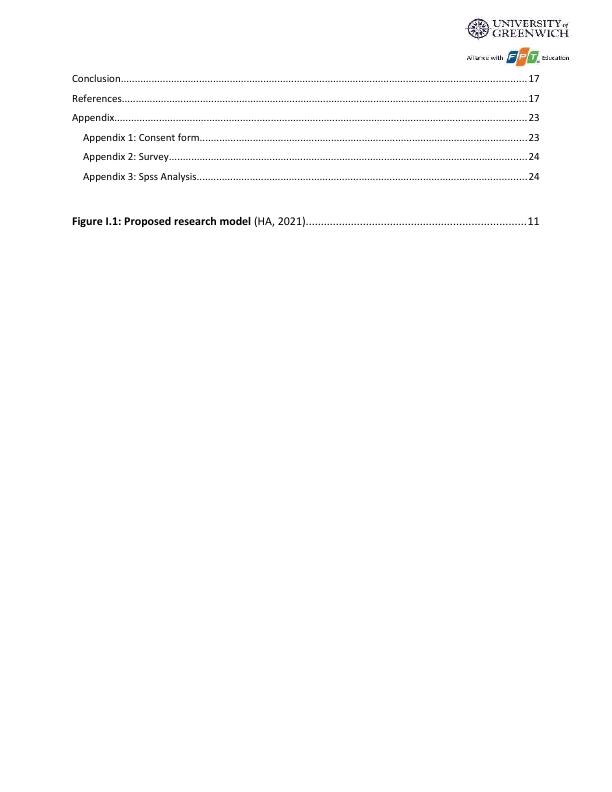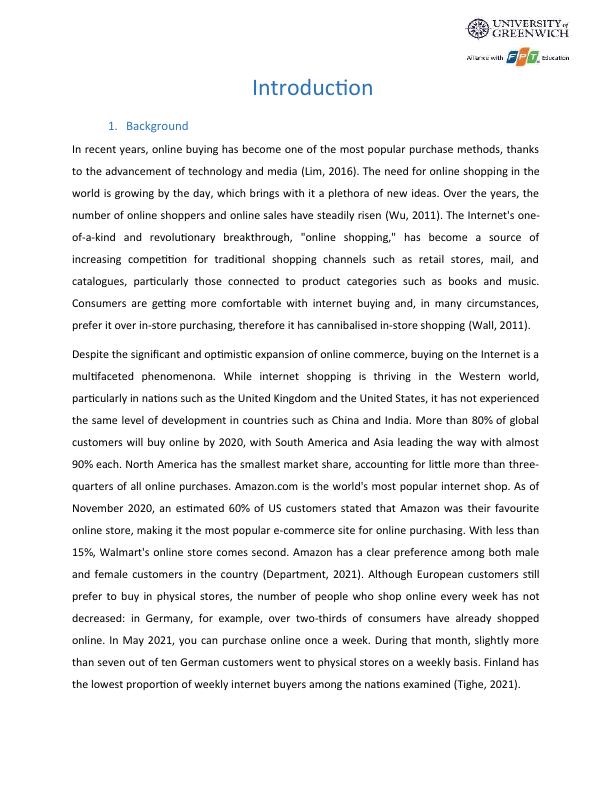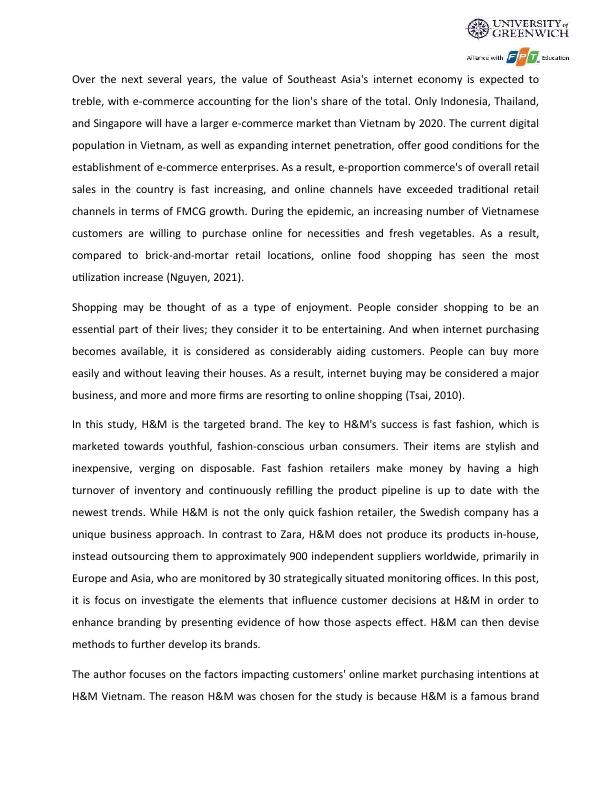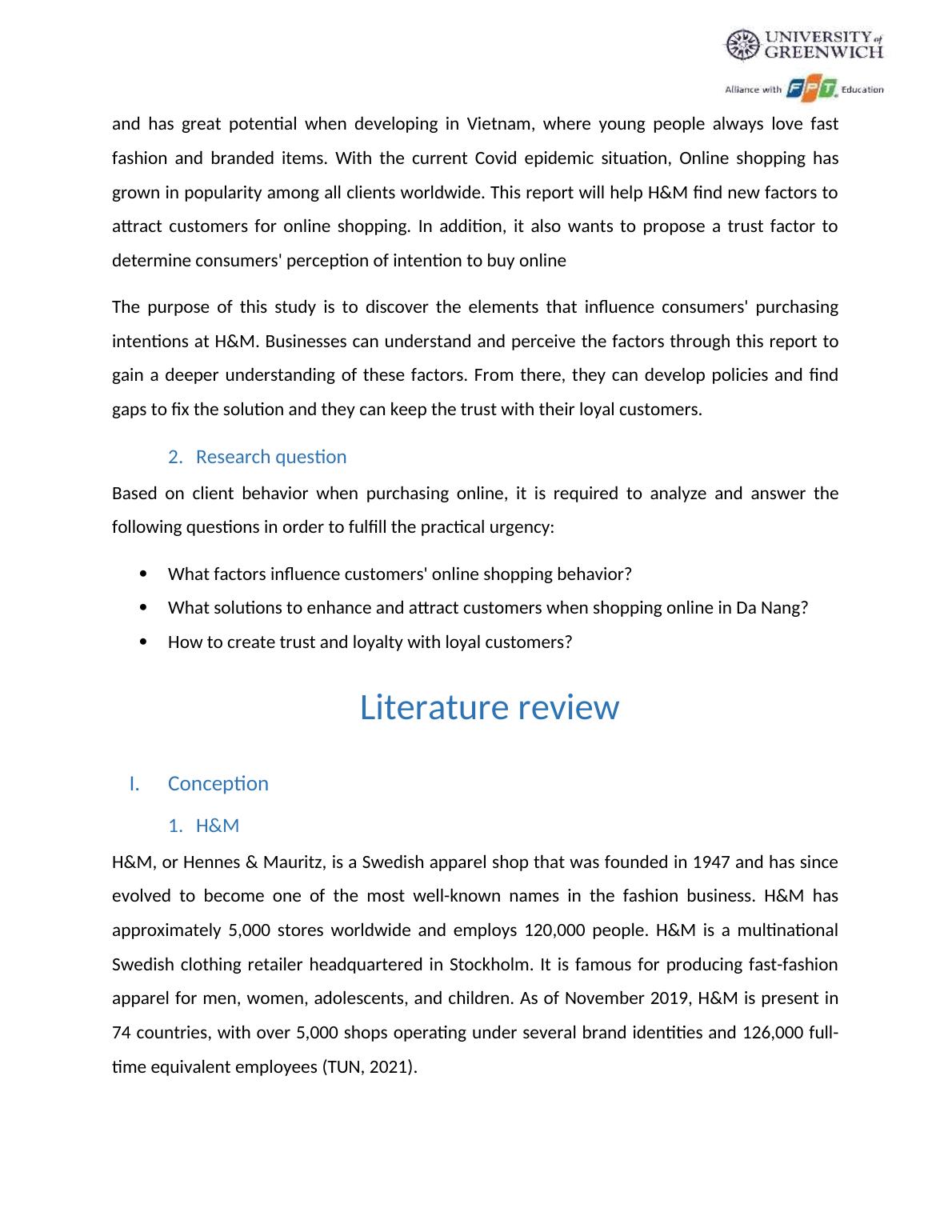Assignment on Factors that Influence
34 Pages7232 Words29 Views
Added on 2022-02-19
Assignment on Factors that Influence
Added on 2022-02-19
ShareRelated Documents
Dissertation
Topic: Factors that influence consumer buying
behavior on online shopping at H&M in Da Nang
citizens (Vietnam)
Topic: Factors that influence consumer buying
behavior on online shopping at H&M in Da Nang
citizens (Vietnam)

Contents
Introduction.................................................................................................................................................3
1. Background......................................................................................................................................3
2. Research question...........................................................................................................................5
Literature review.........................................................................................................................................6
I. Conception..........................................................................................................................................6
1. H&M................................................................................................................................................6
2. Online shopping behavior................................................................................................................6
3. Emprical studies...............................................................................................................................6
4. Factors influencing the online shopping behavior...........................................................................8
a. The shopping attitude..................................................................................................................9
b. Subjective norms.........................................................................................................................9
c. Perceived behavior control........................................................................................................10
d. Perceived usefulness.................................................................................................................10
e. Consumer’s trust.......................................................................................................................10
5. Theoretical Framework..................................................................................................................12
Methodology.............................................................................................................................................12
I. Research method...............................................................................................................................12
1. Research approach........................................................................................................................12
2. Research ethics..............................................................................................................................13
3. Data collection...............................................................................................................................14
4. Research Instruments....................................................................................................................14
5. Data analysis..................................................................................................................................16
Result.........................................................................................................................................................17
1. Descriptive analysis........................................................................................................................17
2. EFA analysis...................................................................................................................................17
3. Independent sample T-test............................................................................................................17
4. One-way ANOVA............................................................................................................................17
Disscusion..................................................................................................................................................17
1. Results summary...........................................................................................................................17
2. Implication.....................................................................................................................................17
3. Limitation.......................................................................................................................................17
4. Suggestions for future research.....................................................................................................17
Introduction.................................................................................................................................................3
1. Background......................................................................................................................................3
2. Research question...........................................................................................................................5
Literature review.........................................................................................................................................6
I. Conception..........................................................................................................................................6
1. H&M................................................................................................................................................6
2. Online shopping behavior................................................................................................................6
3. Emprical studies...............................................................................................................................6
4. Factors influencing the online shopping behavior...........................................................................8
a. The shopping attitude..................................................................................................................9
b. Subjective norms.........................................................................................................................9
c. Perceived behavior control........................................................................................................10
d. Perceived usefulness.................................................................................................................10
e. Consumer’s trust.......................................................................................................................10
5. Theoretical Framework..................................................................................................................12
Methodology.............................................................................................................................................12
I. Research method...............................................................................................................................12
1. Research approach........................................................................................................................12
2. Research ethics..............................................................................................................................13
3. Data collection...............................................................................................................................14
4. Research Instruments....................................................................................................................14
5. Data analysis..................................................................................................................................16
Result.........................................................................................................................................................17
1. Descriptive analysis........................................................................................................................17
2. EFA analysis...................................................................................................................................17
3. Independent sample T-test............................................................................................................17
4. One-way ANOVA............................................................................................................................17
Disscusion..................................................................................................................................................17
1. Results summary...........................................................................................................................17
2. Implication.....................................................................................................................................17
3. Limitation.......................................................................................................................................17
4. Suggestions for future research.....................................................................................................17

Conclusion.................................................................................................................................................17
References.................................................................................................................................................17
Appendix...................................................................................................................................................23
Appendix 1: Consent form.....................................................................................................................23
Appendix 2: Survey................................................................................................................................24
Appendix 3: Spss Analysis......................................................................................................................24
Figure I.1: Proposed research model (HA, 2021).........................................................................11
References.................................................................................................................................................17
Appendix...................................................................................................................................................23
Appendix 1: Consent form.....................................................................................................................23
Appendix 2: Survey................................................................................................................................24
Appendix 3: Spss Analysis......................................................................................................................24
Figure I.1: Proposed research model (HA, 2021).........................................................................11

Introduction
1. Background
In recent years, online buying has become one of the most popular purchase methods, thanks
to the advancement of technology and media (Lim, 2016). The need for online shopping in the
world is growing by the day, which brings with it a plethora of new ideas. Over the years, the
number of online shoppers and online sales have steadily risen (Wu, 2011). The Internet's one-
of-a-kind and revolutionary breakthrough, "online shopping," has become a source of
increasing competition for traditional shopping channels such as retail stores, mail, and
catalogues, particularly those connected to product categories such as books and music.
Consumers are getting more comfortable with internet buying and, in many circumstances,
prefer it over in-store purchasing, therefore it has cannibalised in-store shopping (Wall, 2011).
Despite the significant and optimistic expansion of online commerce, buying on the Internet is a
multifaceted phenomenona. While internet shopping is thriving in the Western world,
particularly in nations such as the United Kingdom and the United States, it has not experienced
the same level of development in countries such as China and India. More than 80% of global
customers will buy online by 2020, with South America and Asia leading the way with almost
90% each. North America has the smallest market share, accounting for little more than three-
quarters of all online purchases. Amazon.com is the world's most popular internet shop. As of
November 2020, an estimated 60% of US customers stated that Amazon was their favourite
online store, making it the most popular e-commerce site for online purchasing. With less than
15%, Walmart's online store comes second. Amazon has a clear preference among both male
and female customers in the country (Department, 2021). Although European customers still
prefer to buy in physical stores, the number of people who shop online every week has not
decreased: in Germany, for example, over two-thirds of consumers have already shopped
online. In May 2021, you can purchase online once a week. During that month, slightly more
than seven out of ten German customers went to physical stores on a weekly basis. Finland has
the lowest proportion of weekly internet buyers among the nations examined (Tighe, 2021).
1. Background
In recent years, online buying has become one of the most popular purchase methods, thanks
to the advancement of technology and media (Lim, 2016). The need for online shopping in the
world is growing by the day, which brings with it a plethora of new ideas. Over the years, the
number of online shoppers and online sales have steadily risen (Wu, 2011). The Internet's one-
of-a-kind and revolutionary breakthrough, "online shopping," has become a source of
increasing competition for traditional shopping channels such as retail stores, mail, and
catalogues, particularly those connected to product categories such as books and music.
Consumers are getting more comfortable with internet buying and, in many circumstances,
prefer it over in-store purchasing, therefore it has cannibalised in-store shopping (Wall, 2011).
Despite the significant and optimistic expansion of online commerce, buying on the Internet is a
multifaceted phenomenona. While internet shopping is thriving in the Western world,
particularly in nations such as the United Kingdom and the United States, it has not experienced
the same level of development in countries such as China and India. More than 80% of global
customers will buy online by 2020, with South America and Asia leading the way with almost
90% each. North America has the smallest market share, accounting for little more than three-
quarters of all online purchases. Amazon.com is the world's most popular internet shop. As of
November 2020, an estimated 60% of US customers stated that Amazon was their favourite
online store, making it the most popular e-commerce site for online purchasing. With less than
15%, Walmart's online store comes second. Amazon has a clear preference among both male
and female customers in the country (Department, 2021). Although European customers still
prefer to buy in physical stores, the number of people who shop online every week has not
decreased: in Germany, for example, over two-thirds of consumers have already shopped
online. In May 2021, you can purchase online once a week. During that month, slightly more
than seven out of ten German customers went to physical stores on a weekly basis. Finland has
the lowest proportion of weekly internet buyers among the nations examined (Tighe, 2021).

Over the next several years, the value of Southeast Asia's internet economy is expected to
treble, with e-commerce accounting for the lion's share of the total. Only Indonesia, Thailand,
and Singapore will have a larger e-commerce market than Vietnam by 2020. The current digital
population in Vietnam, as well as expanding internet penetration, offer good conditions for the
establishment of e-commerce enterprises. As a result, e-proportion commerce's of overall retail
sales in the country is fast increasing, and online channels have exceeded traditional retail
channels in terms of FMCG growth. During the epidemic, an increasing number of Vietnamese
customers are willing to purchase online for necessities and fresh vegetables. As a result,
compared to brick-and-mortar retail locations, online food shopping has seen the most
utilization increase (Nguyen, 2021).
Shopping may be thought of as a type of enjoyment. People consider shopping to be an
essential part of their lives; they consider it to be entertaining. And when internet purchasing
becomes available, it is considered as considerably aiding customers. People can buy more
easily and without leaving their houses. As a result, internet buying may be considered a major
business, and more and more firms are resorting to online shopping (Tsai, 2010).
In this study, H&M is the targeted brand. The key to H&M's success is fast fashion, which is
marketed towards youthful, fashion-conscious urban consumers. Their items are stylish and
inexpensive, verging on disposable. Fast fashion retailers make money by having a high
turnover of inventory and continuously refilling the product pipeline is up to date with the
newest trends. While H&M is not the only quick fashion retailer, the Swedish company has a
unique business approach. In contrast to Zara, H&M does not produce its products in-house,
instead outsourcing them to approximately 900 independent suppliers worldwide, primarily in
Europe and Asia, who are monitored by 30 strategically situated monitoring offices. In this post,
it is focus on investigate the elements that influence customer decisions at H&M in order to
enhance branding by presenting evidence of how those aspects effect. H&M can then devise
methods to further develop its brands.
The author focuses on the factors impacting customers' online market purchasing intentions at
H&M Vietnam. The reason H&M was chosen for the study is because H&M is a famous brand
treble, with e-commerce accounting for the lion's share of the total. Only Indonesia, Thailand,
and Singapore will have a larger e-commerce market than Vietnam by 2020. The current digital
population in Vietnam, as well as expanding internet penetration, offer good conditions for the
establishment of e-commerce enterprises. As a result, e-proportion commerce's of overall retail
sales in the country is fast increasing, and online channels have exceeded traditional retail
channels in terms of FMCG growth. During the epidemic, an increasing number of Vietnamese
customers are willing to purchase online for necessities and fresh vegetables. As a result,
compared to brick-and-mortar retail locations, online food shopping has seen the most
utilization increase (Nguyen, 2021).
Shopping may be thought of as a type of enjoyment. People consider shopping to be an
essential part of their lives; they consider it to be entertaining. And when internet purchasing
becomes available, it is considered as considerably aiding customers. People can buy more
easily and without leaving their houses. As a result, internet buying may be considered a major
business, and more and more firms are resorting to online shopping (Tsai, 2010).
In this study, H&M is the targeted brand. The key to H&M's success is fast fashion, which is
marketed towards youthful, fashion-conscious urban consumers. Their items are stylish and
inexpensive, verging on disposable. Fast fashion retailers make money by having a high
turnover of inventory and continuously refilling the product pipeline is up to date with the
newest trends. While H&M is not the only quick fashion retailer, the Swedish company has a
unique business approach. In contrast to Zara, H&M does not produce its products in-house,
instead outsourcing them to approximately 900 independent suppliers worldwide, primarily in
Europe and Asia, who are monitored by 30 strategically situated monitoring offices. In this post,
it is focus on investigate the elements that influence customer decisions at H&M in order to
enhance branding by presenting evidence of how those aspects effect. H&M can then devise
methods to further develop its brands.
The author focuses on the factors impacting customers' online market purchasing intentions at
H&M Vietnam. The reason H&M was chosen for the study is because H&M is a famous brand

and has great potential when developing in Vietnam, where young people always love fast
fashion and branded items. With the current Covid epidemic situation, Online shopping has
grown in popularity among all clients worldwide. This report will help H&M find new factors to
attract customers for online shopping. In addition, it also wants to propose a trust factor to
determine consumers' perception of intention to buy online
The purpose of this study is to discover the elements that influence consumers' purchasing
intentions at H&M. Businesses can understand and perceive the factors through this report to
gain a deeper understanding of these factors. From there, they can develop policies and find
gaps to fix the solution and they can keep the trust with their loyal customers.
2. Research question
Based on client behavior when purchasing online, it is required to analyze and answer the
following questions in order to fulfill the practical urgency:
What factors influence customers' online shopping behavior?
What solutions to enhance and attract customers when shopping online in Da Nang?
How to create trust and loyalty with loyal customers?
Literature review
3. Conception
1. H&M
H&M, or Hennes & Mauritz, is a Swedish apparel shop that was founded in 1947 and has since
evolved to become one of the most well-known names in the fashion business. H&M has
approximately 5,000 stores worldwide and employs 120,000 people. H&M is a multinational
Swedish clothing retailer headquartered in Stockholm. It is famous for producing fast-fashion
apparel for men, women, adolescents, and children. As of November 2019, H&M is present in
74 countries, with over 5,000 shops operating under several brand identities and 126,000 full-
time equivalent employees (TUN, 2021).
fashion and branded items. With the current Covid epidemic situation, Online shopping has
grown in popularity among all clients worldwide. This report will help H&M find new factors to
attract customers for online shopping. In addition, it also wants to propose a trust factor to
determine consumers' perception of intention to buy online
The purpose of this study is to discover the elements that influence consumers' purchasing
intentions at H&M. Businesses can understand and perceive the factors through this report to
gain a deeper understanding of these factors. From there, they can develop policies and find
gaps to fix the solution and they can keep the trust with their loyal customers.
2. Research question
Based on client behavior when purchasing online, it is required to analyze and answer the
following questions in order to fulfill the practical urgency:
What factors influence customers' online shopping behavior?
What solutions to enhance and attract customers when shopping online in Da Nang?
How to create trust and loyalty with loyal customers?
Literature review
3. Conception
1. H&M
H&M, or Hennes & Mauritz, is a Swedish apparel shop that was founded in 1947 and has since
evolved to become one of the most well-known names in the fashion business. H&M has
approximately 5,000 stores worldwide and employs 120,000 people. H&M is a multinational
Swedish clothing retailer headquartered in Stockholm. It is famous for producing fast-fashion
apparel for men, women, adolescents, and children. As of November 2019, H&M is present in
74 countries, with over 5,000 shops operating under several brand identities and 126,000 full-
time equivalent employees (TUN, 2021).

2. Online shopping behavior
Prior to delving into the elements that impact online purchasing, it is critical to define the
scientific approach to online shopping. Customers can use the Internet to search or seek the
proper goods (CHENG, 2012). When consumers want to purchase online, they utilize the
Internet to obtain relevant information (Kotler, 2016). The term "consumer purchase intention"
refers to the decision-making procedure and the actual environment activity that customers
engage in while assessing, purchasing, using, or disposing of products and services. However, it
does not end with the purchase of a product or service; It also examines the factors that have
an influence on that aim (Khuong, 2016). Companies can construct variables based on client
demands from these influencing elements in order to make online purchase intention.
3. Emprical studies
No
.
Article Methodology Variable/Factor Findings
1 Factors
Influencing
Consumer
Purchase
Intention in
Online Shopping
(Fachmi, 2019).
SPSS 22.0 was used
to perform Multiple
Regression Analysis.
Consumer
purchasing decisions
at online stores are
influenced by trust,
advertising, and e-
service quality.
Trust, advertising, and all of
these factors have a favorable
and significant impact on
online shopping decisions.
According to the study's
findings. Customers will select
Tokopedia, Bukalapak, and
Shopee if they have a high
level of trust, appealing
promotions, and good e-
service quality.
Prior to delving into the elements that impact online purchasing, it is critical to define the
scientific approach to online shopping. Customers can use the Internet to search or seek the
proper goods (CHENG, 2012). When consumers want to purchase online, they utilize the
Internet to obtain relevant information (Kotler, 2016). The term "consumer purchase intention"
refers to the decision-making procedure and the actual environment activity that customers
engage in while assessing, purchasing, using, or disposing of products and services. However, it
does not end with the purchase of a product or service; It also examines the factors that have
an influence on that aim (Khuong, 2016). Companies can construct variables based on client
demands from these influencing elements in order to make online purchase intention.
3. Emprical studies
No
.
Article Methodology Variable/Factor Findings
1 Factors
Influencing
Consumer
Purchase
Intention in
Online Shopping
(Fachmi, 2019).
SPSS 22.0 was used
to perform Multiple
Regression Analysis.
Consumer
purchasing decisions
at online stores are
influenced by trust,
advertising, and e-
service quality.
Trust, advertising, and all of
these factors have a favorable
and significant impact on
online shopping decisions.
According to the study's
findings. Customers will select
Tokopedia, Bukalapak, and
Shopee if they have a high
level of trust, appealing
promotions, and good e-
service quality.

2 Factors
Influencing
Online Purchase
Intentions: An
Case Study in
Vietnam (Khanh,
2014).
Survey
questionnaire,
regression analysis,
regression
assumptions before
utilizing the OLS
method to conduct
a regression,
hierarchical multiple
linear regression,
and hypothesis
testing.
Perceived economic
benefits (PEB),
perceived
merchandise
benefits (PM),
perceived ease of
use (PE), perceived
payment benefits
(PPB), and online
shopping behavior
(B).
The primary goal of this
research is to look into the
elements that influence
customer online purchasing
behavior, which might be one
of the most important topics
in the e-commerce and
marketing fields. However,
little research has been
conducted on online
consumer behavior since it is a
complex socio-technical
phenomena with simply too
many variables.
3 The Influence of
Attitude,
Subjective Norm,
and Website
Usability on
Online Purchase:
Behavior Among
Malaysian Youth
(Nurul Aqila
Hasbullaha.,
2016).
Statistical studies
such as
demographic
profiles, descriptive
analysis, reliability
analysis, correlation
tests, and
regression tests are
all available.
Attitude, subjective
norm, website
usability, and
purchasing purpose
while buying online.
The findings supported the
The Theory of Reasoned
Action (TRA) proposed a
connection between attitude
and behavior. A previous
research also supported this
claim. The study's findings
found that website usability
was seen as the most
important factor, with other
factors having just a minimal
impact on customers'
proclivity to purchase online.
The outcomes of the study
should aid the online business
industry, particularly online
merchants, in acquiring and
retaining clients.
4 Acceptance of
Information
Technology by
Users, Perceived
Utility, and Ease
of Use (Davis,
Analysis of
regression and
measurement
scales.
The perceived utility
and simplicity of
usage.
In all trials, usefulness
correlated with usage
behavior much more than
simplicity of use. According to
regression analysis, rather
than being a parallel, direct
Influencing
Online Purchase
Intentions: An
Case Study in
Vietnam (Khanh,
2014).
Survey
questionnaire,
regression analysis,
regression
assumptions before
utilizing the OLS
method to conduct
a regression,
hierarchical multiple
linear regression,
and hypothesis
testing.
Perceived economic
benefits (PEB),
perceived
merchandise
benefits (PM),
perceived ease of
use (PE), perceived
payment benefits
(PPB), and online
shopping behavior
(B).
The primary goal of this
research is to look into the
elements that influence
customer online purchasing
behavior, which might be one
of the most important topics
in the e-commerce and
marketing fields. However,
little research has been
conducted on online
consumer behavior since it is a
complex socio-technical
phenomena with simply too
many variables.
3 The Influence of
Attitude,
Subjective Norm,
and Website
Usability on
Online Purchase:
Behavior Among
Malaysian Youth
(Nurul Aqila
Hasbullaha.,
2016).
Statistical studies
such as
demographic
profiles, descriptive
analysis, reliability
analysis, correlation
tests, and
regression tests are
all available.
Attitude, subjective
norm, website
usability, and
purchasing purpose
while buying online.
The findings supported the
The Theory of Reasoned
Action (TRA) proposed a
connection between attitude
and behavior. A previous
research also supported this
claim. The study's findings
found that website usability
was seen as the most
important factor, with other
factors having just a minimal
impact on customers'
proclivity to purchase online.
The outcomes of the study
should aid the online business
industry, particularly online
merchants, in acquiring and
retaining clients.
4 Acceptance of
Information
Technology by
Users, Perceived
Utility, and Ease
of Use (Davis,
Analysis of
regression and
measurement
scales.
The perceived utility
and simplicity of
usage.
In all trials, usefulness
correlated with usage
behavior much more than
simplicity of use. According to
regression analysis, rather
than being a parallel, direct

End of preview
Want to access all the pages? Upload your documents or become a member.
Related Documents
Marketing Analysis of Amazonlg...
|11
|1281
|307
Consumer satisfaction score Article 2022lg...
|5
|707
|26
Impacts of Launching Romaqua Group Beer in the UK Market Using E-commerce Platformlg...
|26
|7365
|81
Changes in Trading Patterns and Market Models for E-Businesslg...
|10
|2078
|212
Impact of Online Stores on Shopping Behaviorlg...
|14
|4159
|1
Amazon Smile Business Model and Critical Success Factorslg...
|15
|2548
|76
